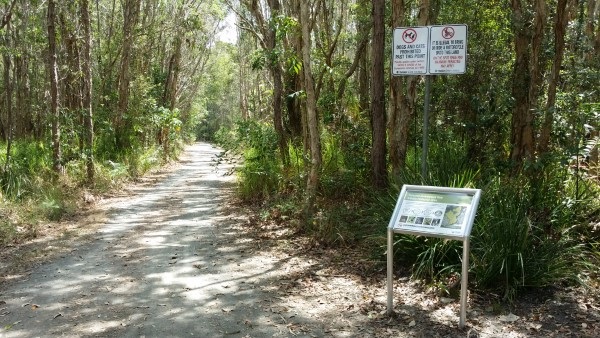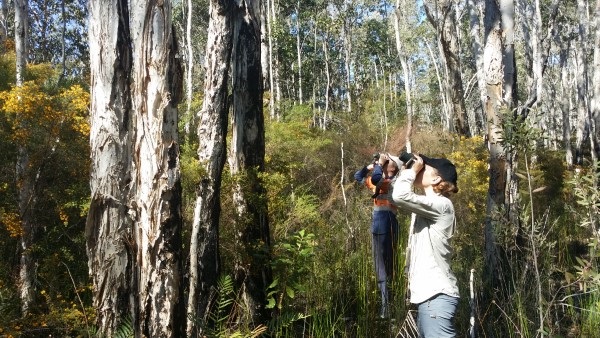Managing bushland
 Council owns or manages approximately 4470 ha of bushland including:
Council owns or manages approximately 4470 ha of bushland including:
- Byrrill Creek and Clarrie Hall Dam catchments
- Mount Nullum
- Tweed Coast Regional Crown Reserve
- Pottsville bushland reserves (Koala Beach, Pottsville Wetland, Pottsville Environment Park)
There are also many smaller areas of bushland in Tweed’s towns and villages.
Classification of public land
There are 2 classifications for public land under the under the Local Government Act 1993.
- Operational land: Part of Council’s bushland estate is used to service the Tweed, such as water catchments.
- Community land: land set aside for community use including conservation.
Tweed Coastal Crown Reserve
The Tweed Coastal Crown Reserve runs the entire 37 kilometre length of the Tweed Coast. It includes bushland owned by the NSW Government but managed by Council.
Protecting our plants and animals
Council’s bushland protects very high conservation value vegetation and fauna habitats:
- forested wetlands
- dry and wet sclerophyll forests
- Littoral and Lowland rainforests
- coastal dunes
- heathland and woodland communities
- estuarine mangrove forests
Many native plants and animals are found here including species threatened with extinction:
- Koala
- Albert’s Lyrebird
- Wallum Froglet
- Common Planigale
- Grey-headed Flying Fox
- Red-legged Pademelon
Council’s bushland estate connects to other large protected areas:
- Wollumbin, Mebbin and Jerusalem National Parks in the Tweed Hinterland
- Cudgen, Wooyung and Billinudgel Nature Reserves on the Tweed Coast
Together these reserves support the movement of plants and animals through the landscape.
Recreation
Our bushland areas offer a chance to enjoy nature and the great outdoors. Popular activities include bushwalking, birdwatching, fauna spotting, picnicking and photography.
See bushwalking and hiking
Managing our bushland reserves
Working together we can protect our bushland areas from weeds, roaming cats and dogs, pest animals, rubbish dumping and fires.
If you see something that needs attention please report a problem.
Wildlife protection areas
A few of Council’s bushland reserves are declared Wildlife Protection Areas. These areas protect native animals and their habitats. No dogs or cats allowed.
Funding for bushland
Council prioritises funding for areas of highest conservation value. This funding helps to restore and protect our threatened plants, animals and natural communities.
Council’s work includes:
- maintaining fences, beach access points, tracks, boardwalks and signs
- threat reduction and recovery work for endangered animals, such as our Tweed Coast koala population
- plant and animal surveys
- weed control, revegetation and ecological restoration
- bushfire risk management and hazard reduction
- pest animal management
- supporting coast, dune and landcare groups working in reserves
We also take action against unlawful activities like vegetation clearing, illegal dumping and dogs in prohibited areas.
Agencies and partnerships - looking after our bushland together

Council works alongside neighbouring land managers and local community groups:
Bushfires
See bushfires.
Bushland regeneration

Council works to restore areas of bushland that have been degraded.
Our bush regeneration programs are long term commitments that include ongoing monitoring and management.
Council engages professional bush regenerators to carry out restoration works.
Works depend on the level of rehabilitation required, and can range from planting native seedlings to controlling weeds so that native plants regenerate and replace weed species.
Restoring our native bushland helps to create healthy and more resilient ecosystems.
Council's restoration projects:
- Controlling Lantana at Mount Nullum and restoring habitat for our vulnerable Albert’s Lyrebird.
- Ongoing bush regeneration in habitat that’s critical for our endangered Koala population at Pottsville Wetland, Pottsville Environment Park and Koala Beach.
- Restoration of critically endangered littoral rainforest remnants along the Tweed Coast.
- Restoration of lowland rainforest remnants and coastal wetland habitats at Banora Point, Tweed Heads West and South, Oxley Cove, Bilambil Heights and Terranora.
- Revegetation of Koala habitat and riparian rainforest at the Cudgerie Bushland reserve.
- Restoration of coastal wetland and Grey-headed flying fox camp habitat at Bray Park Wetland.
- Control of Bitou Bush in the Bitou Bush Biosecurity Zone within the Tweed Coast Regional Crown Reserve.
Learn about bushland regeneration